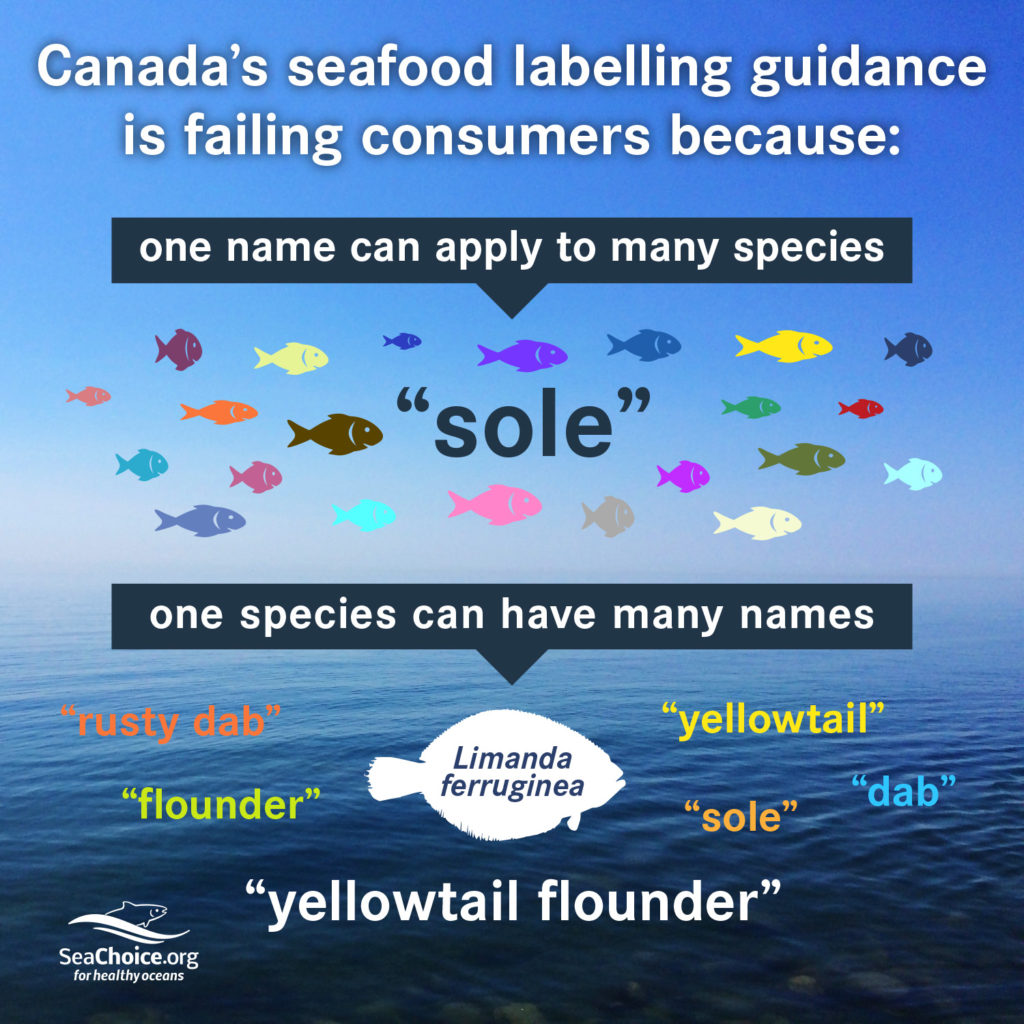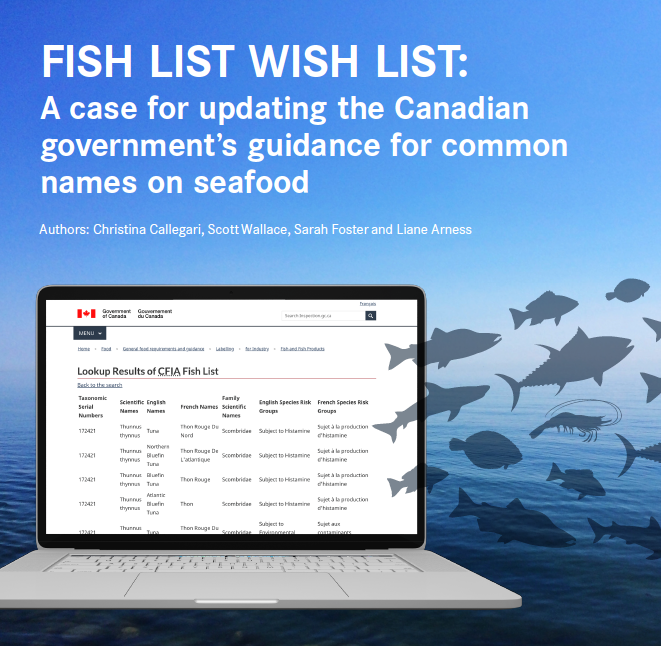The Fish List Wish List: Important changes are needed to Canada’s seafood labelling guidance
When it comes to buying seafood, there’s a good chance you don’t know what you’re getting. SeaChoice is working to help the Canadian government clear up the confusion.
Canada’s seafood labelling laws require product labels to include a common name, but a common name doesn’t tell you which species you’re eating. Many different common names can be used for the same species and many different species can be called the same common name. Improved seafood labelling is important not just for consumer protection, but because different species have different sustainability and health implications.

 SeaChoice’s report “Fish List Wish List: A case for updating the Canadian government’s guidance for common names on seafood” examines the most problematic and misleading common names in the market, providing recommendations for better name clarity. For those short on time, we have also produced an Executive Summary.
SeaChoice’s report “Fish List Wish List: A case for updating the Canadian government’s guidance for common names on seafood” examines the most problematic and misleading common names in the market, providing recommendations for better name clarity. For those short on time, we have also produced an Executive Summary.
In Canada, the guidance for naming seafood products comes from the Canadian Food Inspection Agency (CFIA) and is maintained through the Fish List. The Fish List contains entries for (almost) all of the seafood sold in Canada, and is used by seafood companies, retailers and restaurants to decide what to call the seafood they sell. However, the Fish List seldom requires such vendors to be specific about what it is they’re selling. A seafood package labelled as “rockfish,” for example, could be one of more than 100 possible species, some of which are endangered and some which are sustainably managed. Because the law does not require a scientific name on a seafood product label, these generic common names can leave buyers confused and without the information they need to make informed choices.
SeaChoice’s analysis
Our study examined which common names on the Fish List are used for multiple species, identifying prominent misleading and generic common names for 157 Canadian wild-caught species. We prioritized which species’ common names should be revised first, based on the following criteria: the number of “approved” English common names for the species, whether the species is prone to mislabelling, sustainability or health concerns, and whether species is subject to the U.S. Seafood Import Monitoring Program. We also highlighted inconsistencies and missing information so that the CFIA can improve its guidance.
Key Findings
We found the following four groups of common names highly problematic due to the high number of species they apply to, the risk of ambiguity and the high occurrence of overlap among the associated genera3 and species.
- Snapper, rockfish, rosefish, redfish and Pacific snapper
- Sole and flounder
- Shrimp and prawn
- Dogfish and shark
Our set of analyses of 157 Canadian-caught species revealed:
- 24 are commonly mislabelled in the marketplace, meaning the common name used is not permitted by the CFIA.
- 56 have sustainability concerns associated with their population, such as declining stocks and should be avoided by buyers.
- 81 have health concerns associated with their consumption, such as high levels of mercury or histamines that may cause allergic reactions.
- 23 are subject to the U.S. Seafood Import Monitoring Program, an import regulation requiring stronger record keeping and labelling for higher risk species entering the U.S.
When we examined the number of English common names for these species against the criteria above, species of most concern were Thunnus thynnus (Atlantic bluefin tuna), Sebastes fasciatus (Acadian redfish), Sebastes mentella (deepwater redfish), Sebastes ruberrimus (yelloweye rockfish), Squalus acanthias (spiny dogfish) and Reinhardtius hippoglossoides (Greenland halibut). These species had 4, 5, or 6 different common names permitted by the CFIA, some of which are misleading and generic, and fell under all or many of the criteria.
Finally, our investigation into inconsistencies with the CFIA Fish List revealed that:
- 14 species are missing from the list or have outdated scientific names.
- 16 species or genus-level entries are missing an English or French common name, or both.
- Of the species that are encapsulated in the 99 genus entries in the Fish List (for example the CFIA permits all Sebastes species to be called “rockfish”), 1,661 species are not listed on the Fish List. Accounting for the species represented by genus-level entries means the number of species on the Fish list jumps from 871 to 2,532 species.
You can read more about our findings in the full report or the report’s Executive Summary.
Recommendations
Our findings support the research from other groups4 that requiring a scientific name on seafood product labels would be the universal fix to address all other naming issues identified in this report. In addition, CFIA should dedicate resources to the implementation and enforcement of the Fish List to ensure compliance throughout the seafood supply chain.
We recommend the following changes to the Fish List itself to ensure proper and accurate seafood product labelling
- Provide only the standard common names for the species found as most concerning and reduce and/or remove the generic or misrepresentative common names identified.
- Add species and common names that are missing from the Fish List and ensure all names are up to date.
- Remove all genus-level entries and add a standard common name for any commercially relevant species.
SeaChoice is working with the CFIA to improve its labelling guidance so you know what seafood you’re buying. Sign up for our newsletter to be the first to know how you can help.
[1] Genera, the plural form of the word genus, is a taxonomic category that ranks below family and above species. Genus is a name given to a group of closely related organisms. For example, within the scientific name Homo sapiens, “Homo” refers to the genus.
[2] Hu, Y, Huang, S, Hanner, R, Levin, J & Lu, X (2018). Study of fish products in metro Vancouver using DNA barcoding methods reveals fraudulent labeling, Food Control, vol. 94, pp. 38-47. https://doi.org/10.1016/j.foodcont.2018.06.023
[2] Lowell, B, Mustain, P, Ortenzi, K, Warner, K (2015). One name, one fish: Why seafood names matter. https://usa.oceana.org/sites/default/files/onenameonefishreport.pdf


